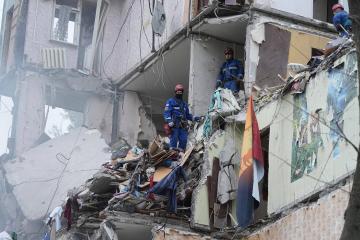A significant overnight aerial assault has left a major metropolitan area grappling with widespread devastation, with numerous fatalities and extensive injuries reported across the urban landscape. This unprecedented incident has prompted immediate emergency responses and highlighted the vulnerability of civilian populations to such large-scale events.
The coordinated attack involved a barrage of advanced aerial devices, with authorities confirming a high number of projectiles targeting various sectors of the city. While many were successfully intercepted by defensive measures, a substantial number bypassed protective systems, resulting in direct impacts on critical infrastructure and residential zones.
Across the capital, over two dozen distinct locations bore the brunt of the assault, leading to substantial structural damage. Residential complexes, educational institutions, healthcare facilities, and commercial buildings sustained considerable harm, displacing countless residents and disrupting essential public services in affected neighborhoods.
The human toll of the incident is profound, with initial reports indicating a tragic loss of life, including young children, and a significant number of individuals requiring urgent medical attention. Emergency services were overwhelmed by the sheer volume of casualties, necessitating a massive mobilization of medical personnel and resources.
Beyond the primary metropolitan target, the effects of the airborne campaign resonated across several peripheral regions, with incidents of falling debris and secondary impacts reported. These widespread disruptions underscore the far-reaching consequences and unpredictable nature of such sophisticated aerial engagements, affecting broader civilian life and regional stability.
In the aftermath, a massive emergency response operation was immediately launched, involving rescue teams, paramedics, and law enforcement. Efforts are concentrated on search and rescue missions in heavily damaged areas, providing aid to the injured, and assessing the full extent of the structural collapse and infrastructural compromise.
The community has rallied in the face of adversity, with countless volunteers assisting official response teams and offering support to those displaced or affected by the tragic events. The resilience of the urban population is evident as they begin the daunting task of recovery and rebuilding amidst the challenging circumstances.
Investigations are underway to ascertain the full scope and origin of these coordinated aerial incursions, with international observers closely monitoring the unfolding situation. The incident serves as a stark reminder of the devastating impact such high-intensity aerial engagements can have on urban environments and the imperative for enhanced protective measures for civilian centers.
This grave event has ignited widespread calls for accountability and reinforced the global dialogue on protecting civilian areas from advanced airborne threats. The focus remains on humanitarian aid, long-term recovery efforts, and ensuring the safety and stability of urban populations in the face of complex and unpredictable challenges.






Leave a Reply